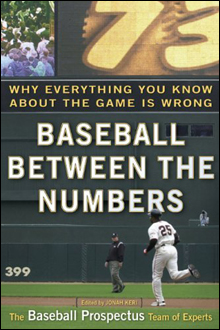 According to the essayists and numbers-crunchers at Baseball Prospectus, the hardball stathead’s Bible, there are “few irrefutable truths” in the game. But through the revamped statistical models of sabermetrics — devised by Bill James and his Society for American Baseball Research (SABR) in the late ’70s, and built upon exponentially by the BP brainiacs and others with the advent of Internet-database capabilities — this cadre of deep-thinking fans aims to get as close to objective truth in as many of the game’s aspects as possible. The metrics they’ve developed have changed the game immensely.
According to the essayists and numbers-crunchers at Baseball Prospectus, the hardball stathead’s Bible, there are “few irrefutable truths” in the game. But through the revamped statistical models of sabermetrics — devised by Bill James and his Society for American Baseball Research (SABR) in the late ’70s, and built upon exponentially by the BP brainiacs and others with the advent of Internet-database capabilities — this cadre of deep-thinking fans aims to get as close to objective truth in as many of the game’s aspects as possible. The metrics they’ve developed have changed the game immensely.
In the new Baseball Between the Numbers: Why Everything You Know about the Game Is Wrong (Basic), the BP team of experts, using abstruse mathematical formulas and lucid prose, disprove commonly-held beliefs like the importance of batting order, the preferability of a five-man rotation, and the assertion that gaudy salaries have led to today’s high ticket prices. We spoke to BP contributor Steven Goldman, who is also editor of Mind Game: How the Boston Red Sox Got Smart, Won a World Series, and Created a New Blueprint for Winning (Workman Publishing), about David Ortiz’s clutch hitting, the Red Sox’ supposed pitching surplus, and his predictions for the coming season.
MIKE MILIARD: Why are some people, the Joe Morgans of the world, so scared of sabermetrics?
STEVEN GOLDMAN: The numbers that we use are really the old numbers remixed in such a way to make them a little more informative. They’re not meant to be off-putting or confusing. We all grew up with statistics available — mostly what was available on the back of a Topps baseball card: batting average, RBIs, all those. It’s only later that you begin to realize they’re not the most important stats out there. In fact, they’re some of the most misleading. I think when the dinosaurs saw the first primitive mammals running across their toes, they got nervous, too. But Joe Morgan is really an outlier. In official baseball circles, this stuff is accepted as a necessary part of understanding the game and knowing what’s going on. Pretty much every team is doing stuff like this, be it the Red Sox hiring Bill James or other teams having people on a consulting basis — some of whom have graduated from Baseball Prospectus to jobs with major-league organizations. Somebody like Joe Morgan, he’s the baseball equivalent of a Luddite. We fear what we do not understand.
I should point out about the subtitle: It’s kind of interesting that people tend to take these subtitles very personally. We really have had e-mail from people who say, “What do you mean, everything I know about baseball is wrong?” You’re almost tempted to write back, ‘Well, not you, Bob.” We should have had the subtitle be “Why Everything Everybody Except Bob Knows About Baseball is Wrong.”
ADVERTISEMENT
 |
MM: If you ask most Red Sox fans, is David Ortiz clutch? They’d probably say, is the Pope Catholic? But you guys aren’t so sure.
SG: One of the reasons sabermetricians are really skeptical of clutch hitting is that you really can’t find, for the most part, a consistent basis where it exists. In other words, if it were something that was a real talent, like juggling, if you could juggle, then every time you pick up three balls, you’re going to be able to juggle. Either you can juggle or you can’t. But for clutch hitting, if you look at a particular player — John Smith in year one comes up with runners on second and third, and hits .375 — and everyone says, “Oh my gosh, he’s a clutch hitter, he drives home so many runs.” But then in year two he hits .175 with runners on second and third. And then it’s “He used to be a clutch hitter.” Players are consistently inconsistent in this way. If there were really players who were clutch hitters in the sense that it was a talent that existed in some way, then you’d see every year, [that] John Smith hit .375 with runners on base.
Now, I think you can take this too far. The fact is that to every rule there are exceptions. And there are players who show pretty good consistency with runners on base. But on the whole, I think it’s true that you can’t identify somebody like that. Has David Ortiz had some big late-inning hits? Yes. But over a period of years, that’s going to even out.
One of the interesting things about clutch hitting is that, no surprise, the players that are good hitters overall are good hitters in the clutch. It doesn’t change. There are very few players who are terrible hitters overall who suddenly turn into Babe Ruth just because a guy is standing on second base with two outs. David Ortiz is Babe Ruth all the time. He’s Babe Ruth with the bases empty and Babe Ruth with a runner on second, so it’s sort of a natural thing that he tends to drive in these runs.